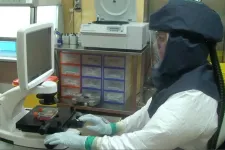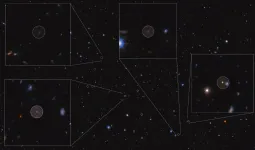Sub-diffraction optical writing information bits: towards a high-capacity optical disk for Big Data
2021-02-26
(Press-News.org) The total amount of data generated worldwide is expected to reach 175 ZB (Zettabytes; 1 ZB equals 1 billion Terabytes) by 2025. If 175 ZB were stored on Blu-ray disks, the disk stack would be 23 times the distance to the Moon. We face the urgent need to develop storage technologies that can accommodate this enormous amount of data.
The demand to store ever-increasing volumes of information has resulted in the widespread implementation of data centers for Big Data. These centers consume massive amounts of energy (about 3% of global electricity supply) and rely on magnetization-based hard disk drives with limited storage capacity (up to 2 TB per disk) and lifespan (up to 3-5 years). Laser-enabled optical data storage is a promising and cost-effective alternative for meeting this unprecedented demand. However, the diffractive nature of light has limited the size of the information bits that can be reached and, as a result, the storage capacity of the optical disks.
Researchers at USST, RMIT and NUS have now overcome this limitation by using earth-rich lanthanide-doped upconversion nanoparticles and graphene oxide flakes. This unique material platform enables low-power optical writing nanoscale information bits (nanoscale refers to sizes of 1-100 nanometers, where one nanometer is one billionth of a meter).
A much-improved data density can be achieved for an estimated storage capacity of 700 TB on a 12-cm optical disk, comparable to a storage capacity of 28,000 Blu-ray disks. Furthermore, the technology uses inexpensive continuous-wave lasers, reducing operating costs compared to traditional optical writing techniques using expensive and bulky pulsed lasers.
This technology also offers the potential for optical lithography of nanostructures in carbon based chips that are highly required in next-generation nanophotonic devices.
The impact
Optical data storage has advanced remarkably over the last decades, but the optical disk storage capacity is still limited to a few Terabytes.
The developed sub-diffraction optical writing technology can produce an optical disk with the largest storage capacity of all available optical devices.
While advances are needed to optimize the technology, the results open new avenues to address the global challenge of data storage. The technology is suited to the mass production of optical disks, so that the potential is enormous.
This ground-breaking technology could offer a cheaper and sustainable solution for the next generation of high-capacity optical data storage while enabling the energy-efficient nanofabrication of flexible graphene based electronics.
INFORMATION:
How it works
The technology uses a new nanocomposite material that combines graphene oxide flakes with upconversion nanoparticles.
Graphene oxide can be seen as a single layer of graphite with different oxygen groups. Reducing graphene oxide by eliminating these oxygen groups produces a material called reduced graphene oxide, which has similar properties to graphene.
Sub-diffraction information bits have been written in the nanocomposite using upconversion nanoparticles to reduce graphene oxide locally upon engineered illumination. The reduction of graphene oxide was induced by high-energy quanta generated in the excited upconversion nanoparticles through a process of resonance energy transfer.
The researchers chose upconversion nanoparticles because they enable efficient sub-diffraction optical writing using low laser beam intensity, resulting in low energy consumption and long lifetime of optical devices.
The team
The research was led by Distinguished Professor Min Gu at the Centre for Artificial-Intelligence Nanophotonics, USST and RMIT University, in collaboration with Professor Xiaogang Liu at the Department of Chemistry, NUS and the N.1 Institute for Health, NUS. The experimental work was led by Dr Simone Lamon, Postdoctoral Research Fellow at USST School of Optical-Electrical and Computer Engineering and RMIT School of Science.
The paper, "Nanoscale optical writing through upconversion resonance energy transfer" is published in Science Advances on Feb. 24, 2021.
ELSE PRESS RELEASES FROM THIS DATE:
2021-02-26
IRS refers to the application of insecticide onto the interior walls of houses.
The study, by the Wits Research Institute for Malaria (WRIM) and the London School of Hygiene and Tropical Medicine (LSHTM), was published in The Lancet on 25 February 2021.
Targeted vs blanket Indoor Residual Spraying
Malaria still represents one of the world's largest health crises, particularly on the African continent where 94% of cases and deaths occur (World Health Organization, 2020).
Most countries in southern Africa have set the elimination of malaria within their borders as a policy target.
In ...
2021-02-26
Prior to the emergence of new mutants of the coronavirus, such as the British variant B.1.1.7, the SARS-CoV-2 variant named D614G had already mutated from the original SARS-CoV-2 pathogen that triggered the pandemic. D614G has rapidly spread to become the most abundant variant worldwide and this D614G mutation remains in all the new emerging variants. An international team including researchers from Bern has now been able to demonstrate in both the laboratory and in animal models why the D614G variant was able to gain the upper hand over the original SARS-CoV-2 virus. "Our approach ...
2021-02-26
A study, led by researchers at the Instituto de Astrofísica de Canarias (IAC) and carried out with OSIRIS, an instrument on the Gran Telescopio Canarias (GTC), has found the most densely populated galaxy cluster in formation in the primitive universe. The researchers predict that this structure, which is at a distance of 12.5 billion light years from us, will have evolved becoming a cluster similar to that of Virgo, a neighbour of the Local Group of galaxies to which the Milky Way belongs. The study is published in the specialized journal Monthly Notices of the Royal Astronomical Society (MNRAS).
Clusters of galaxies are groups of galaxies which remain together because of the action of gravity. To understand the evolution of these "cities of galaxies" scientists look ...
2021-02-26
Researchers from the Andalusian Centre for Molecular Biology and Regenerative Medicine (CABIMER), in collaboration with the Swiss Institute for Experimental Cancer Research (ISREC) have studied the mechanisms behind the higher tendency of people with Mulibrey syndrome to develop tumours. Their results point to the important role of the TRIM37 protein, whose absence explains the appearance of tumour cells.
Mulibrey syndrome is a so-called rare disease as it occurs in less than 5 out of every 10,000 inhabitants. Some of these diseases usually have a very definite genetic basis. ...
2021-02-26
If light is strongly concentrated in time and space, resulting in extreme photon densities, it can enable interaction with all conceivable materials. By using these ultrashort laser foci, even transparent materials can be modified, even though they ordinarily would not interact. Short, focused laser pulses can overcome this transparency and allow energy to be deposited completely contact-free. The exact response of the material to the radiation can be very diverse, ranging from marginal refractive index changes to destructive microscale explosions that evacuate entire areas.
Using the laser pulses for optical machining allows for equally diverse material modification, such as separating or joining using the same laser system. Due to the extremely short exposure time and low degree ...
2021-02-26
Based on a manual recently discovered in a 3,500-year-old medical papyrus, University of Copenhagen Egyptologist Sofie Schiødt has been able to help reconstruct the embalming process used to prepare ancient Egyptians for the afterlife. It is the oldest surviving manual on mummification yet discovered.
In ancient Egypt, embalming was considered a sacred art, and knowledge of the process was the preserve of very few individuals. Most secrets of the art were probably passed on orally from one embalmer to the other, Egyptologists believe, so written evidence is scarce; until recently, only two texts on mummification had been identified.
Egyptologists were therefore surprised to find a short manual on embalming in a medical text that is primarily concerned with ...
2021-02-26
"Everyone's unique" is a popular maxim. All people are equal, but there are of course individual differences. This was no different with dinosaurs. A study by researchers at the University of Bonn and the Dinosaur Museum Frick in Switzerland has now revealed that the variability of Plateosaurus trossingensis was much greater than previously assumed. The paleontologists examined a total of 14 complete skulls of this species, eight of which they described for the first time. The results have now been published in the scientific journal "Acta Palaeontologica Polonica".
Plateosaurus lived during the Late Triassic, about 217 to 201 million years ago. "With well over 100 skeletons, some of them completely preserved, ...
2021-02-26
The latest developments in fluorescence microscopy make it possible to image individual molecules in cells or molecular complexes with a spatial resolution of up to 20 nanometres. However, under certain circumstances, an effect occurs that falsifies the results: the laser light used can cause very reactive oxygen molecules to form in the sample. These can then damage the fluorescent dyes used to such an extent that they no longer fluoresce. Among microscopy experts, this effect is known as photobleaching.
However, various fluorescent dyes can also be transformed by photobleaching so that they absorb light of shorter wavelengths. "A previously red fluorescent dye then glows green. Its fluorescence ...
2021-02-26
A study by researchers at William & Mary's Virginia Institute of Marine Science suggests that continued warming of Atlantic coastal waters may enhance the spread of invasive blue catfish within the Chesapeake Bay and other estuaries along the U.S. East Coast.
The research, by Drs. Vaskar Nepal and Mary Fabrizio of VIMS, appeared in a recent issue of PLOS ONE. It builds on an earlier study by the two authors showing that blue catfish can better tolerate salinity spikes than most freshwater fishes, and thus may be able to expand their range downstream into mainstem Chesapeake waters, and from there into new Bay tributaries and even Delaware Bay. "Blue cats" were introduced to tidal freshwater stretches of the James, York, and Rappahannock rivers during the 1970s and 1980s ...
2021-02-26
Researchers at the Lady Davis Institute (LDI) at the Jewish General Hospital have discovered that increased levels of the protein OAS1 are associated with reduced mortality and less severe disease requiring ventilation among patients with COVID-19. Using drugs that boost OAS1 levels could be explored to try to improve these outcomes. The findings are published today in Nature Medicine.
"Our analysis shows evidence that OAS1 has a protective effect against COVID-19 susceptibility and severity," explains Dr. Brent Richards, a senior investigator at the LDI's Centre for Clinical Epidemiology and Professor of Medicine, Human Genetics, Epidemiology and Biostatistics at McGill University. "This is a very ...
LAST 30 PRESS RELEASES:
[Press-News.org] Sub-diffraction optical writing information bits: towards a high-capacity optical disk for Big Data






